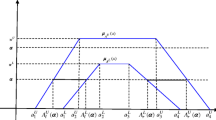Abstract
The polygonal fuzzy set is an effective tool to approximate the general fuzzy set by means of a finite number of ordered real numbers. It not only overcomes the shortcomings (which does not satisfy the closeness) of arithmetic operations of fuzzy sets based on Zadeh extension principle, but also realizes the non-linear operation of general fuzzy sets by an ordered representation of the polygonal fuzzy set. In this paper, the definition, geometric interpretation, ordered representation and arithmetic operations of the polygonal fuzzy sets are introduced for the first time, and the method of solving polygonal fuzzy sets and their ordered representation based on convex fuzzy sets are given by an example. Second, a new Euclidean metric of polygonal fuzzy sets is proposed, and the approximation accuracy of polygonal fuzzy sets to convex fuzzy sets is discussed. In addition, the linear function describing transportation cost index information of logistics companies is obtained through the ordered representation of Gauss membership function, and according to the ordered representation a new normalization method for the polygonal decision matrix is given. Finally, the method of solving the positive (negative) ideal solution and degree of relative closeness of the polygonal decision matrix is suggested by the weighted Euclidean distance. Then a new TOPSIS evaluation system is established, and the effectiveness of the proposed method is illustrated by an example of logistics transportation.















Similar content being viewed by others
References
Zadeh, L.A.: Fuzzy sets. Inf. Control 8(3), 338–353 (1965)
Negeita, C.V., Ralescu, D.A. (eds.) Application of fuzzy sets to system analysis. Wiley, New York (1975)
Mizumoto, M.: K Tanaka. The four operations of arithmetic on fuzzy numbers, Syst. Comp. Controls 7(5):73–81 (1976)
Dubois, D., Prade, H.: Operations on fuzzy numbers. Int. J. Syst. Sci. 9, 613–626 (1978)
Diamond, P.: P Kloeden. World Scientific Press, Metric Spaces Fuzzy Sets (1994)
Turksen, I.B.: Interval valued fuzzy sets based on normal forms[J]. Fuzzy Sets Syst. 20(2), 191–210 (1986)
Burillo, P., Bustince, H., Mohedeno, V.: Some definition of intuitionistic fuzzy number. Fuzzy Based Expert Systems, Fuzzy Bulgarian Enthusiasts (1994)
Torra, V.: Hesitant fuzzy sets. Int. J. Intell. Syst. 25(6), 529–539 (2010)
Xu, Z., Xia, M.: Distance and similarity measures for hesitant fuzzy sets. Inf. Sci. 181(11), 2128–2138 (2011)
Yager, R.R.: Pythagorean membership grades in multi-criteria decision making. IEEE Trans Fuzzy Systems 22(4), 958–965 (2014)
Atanassov, K.: Intuitionistic fuzzy sets. Fuzzy Sets Syst. 20(1), 87–96 (1986)
Atanassov, K., Gargov, G.: Interval valued intuitionistic fuzzy sets. Fuzzy Sets Syst. 31(3), 343–349 (1989)
Wang, J.Q.: Multi-criteria interval intuitionistic fuzzy decision making approach with incomplete certain information. Control Decis. 21(11), 1253–1256 (2006)
Wang, J.Q., Zhang, Z.: Multi-criteria decision-making method with incomplete certain information based on intuitionistic trapezoidal fuzzy number. Control Decis. 24(2), 226–230 (2009)
Wei, G.W.: Some geometric aggregation functions and their application to dynamic multiple attribute decision making in the intuitionistic fuzzy setting. Int. J. Uncertainty Fuzziness Knowl. Based Syst. 17(2), 179–196 (2009)
Xu, Z. S.: Approaches to multiple attribute decision making with intuitionistic fuzzy preference information. Syst. Eng. Theory Pract. 27(11), 62–71 (2007)
Xu, Z.S.: Models for multiple attribute decision making with intuitionistic fuzzy information. Int. J. Uncertainty, Fuzziness Knowl. Based Syst. 15(3), 285–297 (2007)
Xu, Z.S., Yager, R.R.: Some geometric aggregation operators based on intuitionistic fuzzy sets. Int. J. General Syst. 35(4), 417–433 (2006)
Xu, Z.S.: Multi-person multi-attribute decision making models under intuitionistic fuzzy environment. Fuzzy Opimization Decision Making 6(3), 221–236 (2007)
Lan, R., Fan, J.L.: New complete metric on trapezoidal fuzzy numbers and its application to multi-criteria decision-making. Chin. J. Eng. Math 27(6), 1001–1008 (2010)
Zhang, M.J., Nan, J.X., Li, D.F., et al.: TOPSIS for MADM with triangular intuitionistic fuzzy numbers. Operations Res. Manag 21(5), 96–101 (2012)
Wei, G.W.: Some arithmetic aggregation operators with intuitionistic trapezoidal fuzzy numbers and their application to group decision making. J. Comp. 5(3), 345–351 (2010)
Wan, S.P., Dong, J.Y.: Method of intuitionistic trapezoidal fuzzy number for multi-attribute group decision. Control Decis. 25(5), 773–776 (2010)
Wan, S.P.: Multi-attribute decision making based on interval-valued intuitionistic trapezoidal fuzzy number. Control Decis. 26(6), 854–860 (2011)
Wang, Y.M., Que, C.P., Lan, Y.X.: Hesitant fuzzy TOPSIS multi-attribute decision method based on prospect theory. Control Decis. 32(5), 864–870 (2017)
Liu, P.Y.: A new fuzzy neural network and its approximation capability. Sci. China (E) 32(1), 76–86 (2002)
Wang, G.J., Li, X.P.: Universal approximation of polygonal fuzzy neural networks in sense of K-integral norms. Science China. Inf. Sci 54(11), 2307–2323 (2011)
Wang, G.J., He, Y., Li, X.P.: Optimization algorithms for MISO polygonal fuzzy neural networks. Science China. Inf. Sci 45(5), 650–667 (2015)
Wang, G.J., Suo, C.F.: The isolation layered optimization algorithm of MIMO polygonal fuzzy neural network. Neural Comput. Appl. 29(10), 721–731 (2018)
Wang, G. J., Duan, Y.: TOPSIS approach for multi-attribute decision making problems based on n-intuitionistic polygonal fuzzy sets description. Comput. Ind. Eng. 124, 573–581 (2018)
Duan, Y., Wang, G.J.: A FCM clustering algorithm based on polygonal fuzzy numbers to describe multiple attribute index information. Syst. Eng. Theory Pract. 36(12), 3220–3228 (2016)
Wang, G.J.: Polygonal fuzzy neural network and fuzzy system approximation. Science Press, Beijing (2017)
Funding
This work has been supported by National Natural Science Foundation of China (Grant No. 61374009).
Author information
Authors and Affiliations
Corresponding author
Rights and permissions
About this article
Cite this article
Wang, G., Tao, Y. & Li, Y. TOPSIS Evaluation System of Logistics Transportation Based on an Ordered Representation of the Polygonal Fuzzy Set. Int. J. Fuzzy Syst. 22, 1565–1581 (2020). https://doi.org/10.1007/s40815-020-00861-6
Received:
Revised:
Accepted:
Published:
Issue Date:
DOI: https://doi.org/10.1007/s40815-020-00861-6




